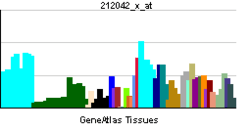60S ribosomal protein L7
| View/Edit Human | View/Edit Mouse |
60S ribosomal protein L7' is a protein that in humans is encoded by the RPL7 gene.[3][4][5]
Ribosomes, the organelles that catalyze protein synthesis, consist of a small 40S subunit and a large 60S subunit. Together these subunits are composed of 4 RNA species and approximately 80 structurally distinct proteins. This gene encodes a ribosomal protein that is a component of the 60S subunit. The protein belongs to the L30P family of ribosomal proteins. It contains an N-terminal basic region-leucine zipper (BZIP)-like domain and the RNP consensus submotif RNP2. In vitro the BZIP-like domain mediates homodimerization and stable binding to DNA and RNA, with a preference for 28S rRNA and mRNA. The protein can inhibit cell-free translation of mRNAs, suggesting that it plays a regulatory role in the translation apparatus. It is located in the cytoplasm. The protein has been shown to be an autoantigen in patients with systemic autoimmune diseases, such as systemic lupus erythematosus. As is typical for genes encoding ribosomal proteins, there are multiple processed pseudogenes of this gene dispersed through the genome.[5]
Interactions
RPL7 has been shown to interact with ZNF7.[6]
References
- ↑ "Human PubMed Reference:".
- ↑ "Mouse PubMed Reference:".
- ↑ Seshadri T, Uzman JA, Oshima J, Campisi J (September 1993). "Identification of a transcript that is down-regulated in senescent human fibroblasts. Cloning, sequence analysis, and regulation of the human L7 ribosomal protein gene". J Biol Chem. 268 (25): 18474–80. PMID 8360149.
- ↑ Hemmerich P, von Mikecz A, Neumann F, Sozeri O, Wolff-Vorbeck G, Zoebelein R, Krawinkel U (March 1993). "Structural and functional properties of ribosomal protein L7 from humans and rodents". Nucleic Acids Res. 21 (2): 223–31. doi:10.1093/nar/21.2.223. PMC 309096
 . PMID 8441630.
. PMID 8441630. - 1 2 "Entrez Gene: RPL7 ribosomal protein L7".
- ↑ Witte, S; Krawinkel U (August 1997). "Specific interactions of the autoantigen L7 with multi-zinc finger protein ZNF7 and ribosomal protein S7". J. Biol. Chem. UNITED STATES. 272 (35): 22243–7. doi:10.1074/jbc.272.35.22243. ISSN 0021-9258. PMID 9268371.
Further reading
- Wool IG, Chan YL, Glück A (1996). "Structure and evolution of mammalian ribosomal proteins.". Biochem. Cell Biol. 73 (11–12): 933–47. doi:10.1139/o95-101. PMID 8722009.
- von Mikecz A, Hemmerich P, Peter HH, Krawinkel U (1995). "Characterization of eukaryotic protein L7 as a novel autoantigen which frequently elicits an immune response in patients suffering from systemic autoimmune disease". Immunobiology. 192 (1–2): 137–54. doi:10.1016/S0171-2985(11)80413-4. PMID 7750987.
- Neumann F, Hemmerich P, von Mikecz A, et al. (1995). "Human ribosomal protein L7 inhibits cell-free translation in reticulocyte lysates and affects the expression of nuclear proteins upon stable transfection into Jurkat T-lymphoma cells". Nucleic Acids Res. 23 (2): 195–202. doi:10.1093/nar/23.2.195. PMC 306654
 . PMID 7862521.
. PMID 7862521. - Maruyama K, Sugano S (1994). "Oligo-capping: a simple method to replace the cap structure of eukaryotic mRNAs with oligoribonucleotides". Gene. 138 (1–2): 171–4. doi:10.1016/0378-1119(94)90802-8. PMID 8125298.
- Witte S, Krawinkel U (1997). "Specific interactions of the autoantigen L7 with multi-zinc finger protein ZNF7 and ribosomal protein S7". J. Biol. Chem. 272 (35): 22243–7. doi:10.1074/jbc.272.35.22243. PMID 9268371.
- Suzuki Y, Yoshitomo-Nakagawa K, Maruyama K, et al. (1997). "Construction and characterization of a full length-enriched and a 5'-end-enriched cDNA library". Gene. 200 (1–2): 149–56. doi:10.1016/S0378-1119(97)00411-3. PMID 9373149.
- Kenmochi N, Kawaguchi T, Rozen S, et al. (1998). "A map of 75 human ribosomal protein genes". Genome Res. 8 (5): 509–23. doi:10.1101/gr.8.5.509. PMID 9582194.
- Andersen JS, Lyon CE, Fox AH, et al. (2002). "Directed proteomic analysis of the human nucleolus". Curr. Biol. 12 (1): 1–11. doi:10.1016/S0960-9822(01)00650-9. PMID 11790298.
- Brezillon S, Lannoy V, Franssen JD, et al. (2003). "Identification of natural ligands for the orphan G protein-coupled receptors GPR7 and GPR8". J. Biol. Chem. 278 (2): 776–83. doi:10.1074/jbc.M206396200. PMID 12401809.
- Strausberg RL, Feingold EA, Grouse LH, et al. (2003). "Generation and initial analysis of more than 15,000 full-length human and mouse cDNA sequences". Proc. Natl. Acad. Sci. U.S.A. 99 (26): 16899–903. doi:10.1073/pnas.242603899. PMC 139241
 . PMID 12477932.
. PMID 12477932. - Kasai H, Nadano D, Hidaka E, et al. (2003). "Differential expression of ribosomal proteins in human normal and neoplastic colorectum". J. Histochem. Cytochem. 51 (5): 567–74. doi:10.1177/002215540305100502. PMID 12704204.
- Odintsova TI, Müller EC, Ivanov AV, et al. (2004). "Characterization and analysis of posttranslational modifications of the human large cytoplasmic ribosomal subunit proteins by mass spectrometry and Edman sequencing". J. Protein Chem. 22 (3): 249–58. doi:10.1023/A:1025068419698. PMID 12962325.
- Gerhard DS, Wagner L, Feingold EA, et al. (2004). "The status, quality, and expansion of the NIH full-length cDNA project: the Mammalian Gene Collection (MGC)". Genome Res. 14 (10B): 2121–7. doi:10.1101/gr.2596504. PMC 528928
 . PMID 15489334.
. PMID 15489334. - Rush J, Moritz A, Lee KA, et al. (2005). "Immunoaffinity profiling of tyrosine phosphorylation in cancer cells". Nat. Biotechnol. 23 (1): 94–101. doi:10.1038/nbt1046. PMID 15592455.
- Andersen JS, Lam YW, Leung AK, et al. (2005). "Nucleolar proteome dynamics". Nature. 433 (7021): 77–83. doi:10.1038/nature03207. PMID 15635413.
- Ko JR, Wu JY, Kirby R, et al. (2006). "Mapping the essential structures of human ribosomal protein L7 for nuclear entry, ribosome assembly and function". FEBS Lett. 580 (16): 3804–10. doi:10.1016/j.febslet.2006.05.073. PMID 16797011.
- Wu WC, Liu HW, Lin A (2007). "Human ribosomal protein L7 displays an ER binding property and is involved in ribosome-ER association". FEBS Lett. 581 (4): 651–7. doi:10.1016/j.febslet.2007.01.023. PMID 17258209.

